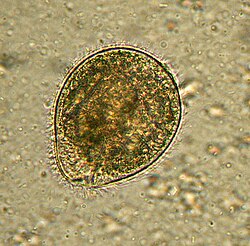709 2017 1147 Fig3c
Autor/Urheber:
Thomas Cavalier-Smith (caption slightly moved, digitylly enhanced)
Attribution:
Das Bild ist mit 'Attribution Required' markiert, aber es wurden keine Informationen über die Attribution bereitgestellt. Vermutlich wurde bei Verwendung des MediaWiki-Templates für die CC-BY Lizenzen der Parameter für die Attribution weggelassen. Autoren und Urheber finden für die korrekte Verwendung der Templates hier ein Beispiel.
Shortlink:
Quelle:
Größe:
620 x 618 Pixel (61142 Bytes)
Beschreibung:
Membrane structre of an algal chromista cell (myzozoa). These originated by secondary intracellular enslavement of a red algal plant cell. Both target nuclear-coded proteins to plastids by transit peptides (TPs) recognised by outer membrane (OM, blue) Toc receptors and to mitochondria (enslaved α-proteobacteria) by topogenic sequences recognised by OM Tom receptors. For clarity, peroxisomes and lysosomes omitted.
Myzozoa lack periplastid ribosomes, phycobilins, and nucleomorph DNA; thylakoids are stacked in threes; PPM (present in Apicomplexa—red dashed line; lost in Dinozoa) and plastids are not within the rough ER. The original phagosome membrane (now epiplastid membrane, EpM) remains smooth and receives vesicles (V) containing nucleus-encoded plastid proteins from the Golgi. Dinozoa lack PR, but Apicomplexa have a likely homologue (not shown).
Myzozoa lack periplastid ribosomes, phycobilins, and nucleomorph DNA; thylakoids are stacked in threes; PPM (present in Apicomplexa—red dashed line; lost in Dinozoa) and plastids are not within the rough ER. The original phagosome membrane (now epiplastid membrane, EpM) remains smooth and receives vesicles (V) containing nucleus-encoded plastid proteins from the Golgi. Dinozoa lack PR, but Apicomplexa have a likely homologue (not shown).
Lizenz:
Credit:
Fig. 3c at https://link.springer.com/article/10.1007/s00709-017-1147-3 Kingdom Chromista and its eight phyla: a new synthesis emphasising periplastid protein targeting, cytoskeletal and periplastid evolution, and ancient divergences. In: Protoplasma 255,pages 297–357, doi:10.1007/s00709-017-1147-3
Relevante Bilder
Relevante Artikel
AlveolataDie Alveolata bilden ein Taxon einzelliger Eukaryoten. Zu ihnen gehören unter anderem die Dinoflagellaten (Dinoflagellata), die Apicomplexa und die Wimpertierchen (Ciliophora). Alle drei Stämme enthalten komplexe einzellige Lebewesen. .. weiterlesen


